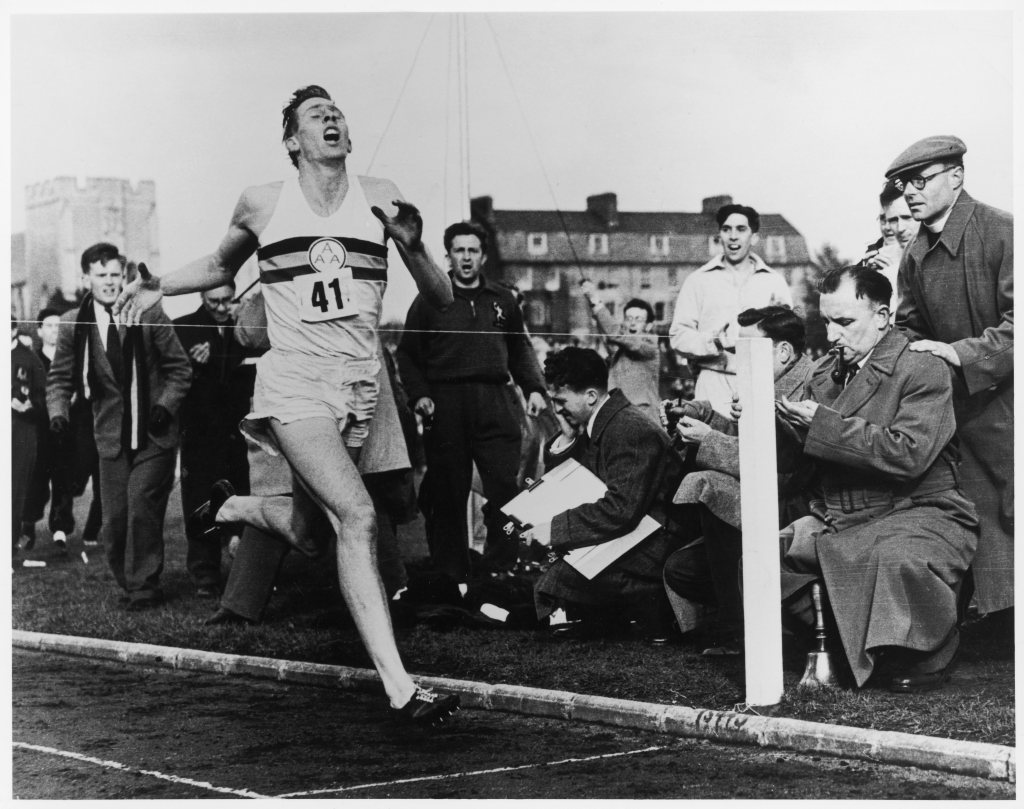Feature: The miracle mile
This is the story of the most famous race ever run in Canada
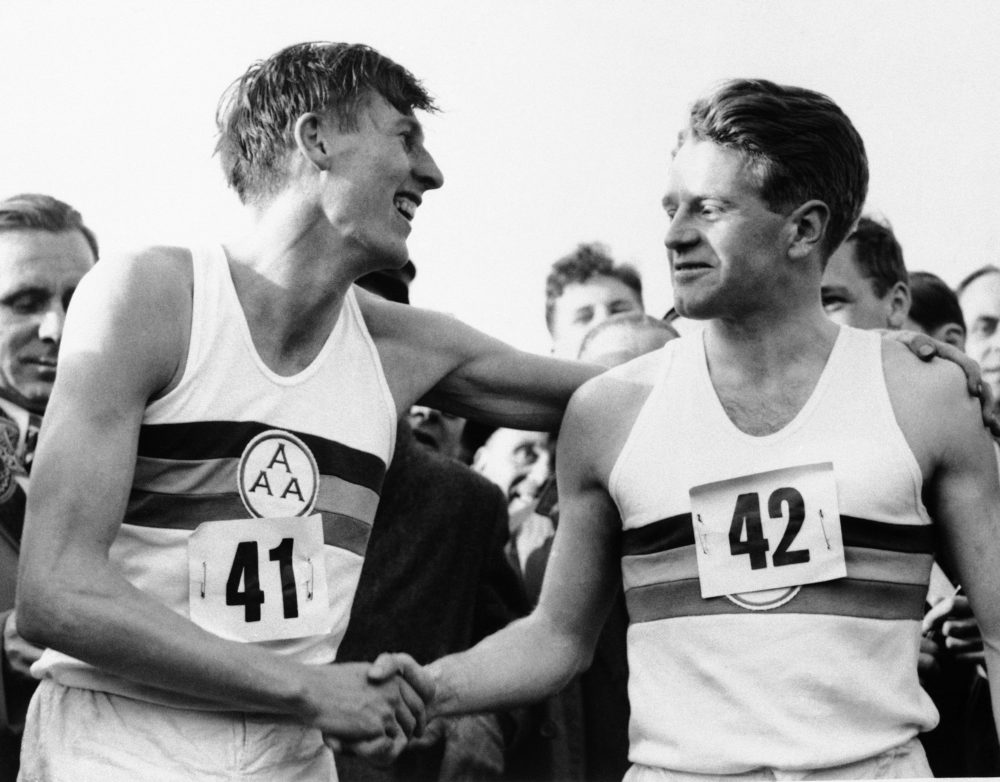
By Roger Robinson
In 1954, in Vancouver, Roger Bannister and John Landy changed sport forever. Roger Robinson looks back on the greatest race ever run on Canadian soil.
Vancouver, August 7, 1954
Only two men in the world have ever run a mile faster than four minutes.
Both are here. Three months ago, May 6, in Oxford, England, Roger Bannister was the first to break the supposedly impossible barrier. His 3:59.4 made him an instant legend. With the world still catching its breath, John Landy of Australia did something equally unthinkable. On June 21, in Turku, Finland, Landy ran more than a second faster than Bannister’s time: 3:58.0.
The barrier breaker and the world record holder come together at the Vancouver’s Empire Stadium for the one-mile final of the British Empire and Commonwealth Games. Public and media interest was passionate. The anticipation overshad- owed everything else in the Games. It was already being called the “Miracle Mile.” Eight men took their marks.
This is the story of the most famous race ever run in Canada.
Roger Bannister and John Landy followed each other’s 1952–4 results intently, even in those days of slow-moving global news. The race for the first-four minute mile was a long-range, three-sided one, seasonally off-kilter, with Bannister in Oxford and London, Landy in Melbourne, and a crewcut American farm boy, Wes Santee, at the University of Kansas.
All three had been at the Olympic Games in Helsinki in 1952, when Bannister’s best mile was 4:07.8, Landy’s 4:11 and Santee’s 4:08.8. Santee was eliminated in a heat of the 5,000m. Landy and Bannister ran in the same 1,500m heat, with Landy eliminated, while the nerve-wracked Bannister progressed unconvincingly through the semis to the final, where he finished a disappointing fourth.
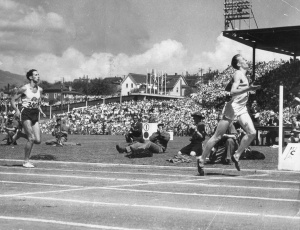 On the advice of the great runner Emil Zatopek, Landy dramati- cally increased his workload of interval training and in December 1952 suddenly ran a solo 4:02.1, the world’s fastest mile since Gundar Hägg’s world record 4:01.3 in 1945. The global rivalry for the first sub-4-minute mile began.
On the advice of the great runner Emil Zatopek, Landy dramati- cally increased his workload of interval training and in December 1952 suddenly ran a solo 4:02.1, the world’s fastest mile since Gundar Hägg’s world record 4:01.3 in 1945. The global rivalry for the first sub-4-minute mile began.
RELATED: Vancouver’s SkyTrain system mapped out in a runner-friendly way.
In 1954, the double sensation of Bannister and Landy breaking four put the world’s media into feeding frenzy for the grand decider in Vancouver. Bannister complained of journalists “comparing our chest measurements and trying to find out what toothpaste we used.” With a borrowed car, he escaped the attention. Reticent and self-absorbed to a degree that was often perceived as arrogant, Bannister was a contrast to the relaxed and courteous Aussie. Landy trained twice a day on the main track, with every session reported in detail, while Bannister did his lighter training and occasional time trials out of sight on a golf course. Landy could be reticent, too. He kept it quiet when the day before the heats, he trod barefoot on a flashbulb and gashed his foot.
They met briefly soon after Bannister’s arrival. “I was conscious of blushing as we met, but he showed no trace of awkwardness. He had a very attractive personality and seemed most friendly,” Bannister wrote in First Four Minutes (1955).
Other contenders took sides. Murray Halberg, the 21-year-old New Zealander who was the only threat to the big two, liked Landy and found Bannister and his Oxbridge friends standoffish. “They declined to enjoy the company of anyone else,” Halberg wrote in A Clean Pair of Heels (1963).
Many of England’s own team felt the same. Jim Peters, the marathon world record holder, befriended the New Zealanders, and complained about the division in the English team between the club runners and the “univer- sity types.” While the fault for that long-standing division was not all on one side, Bannister did nothing to alleviate it. The feeling in favour of Landy affected the way the Miracle Mile itself was run.
It began in the heats. Bannister was thick with a head cold. The number two Australian, Geoff Warren, led out at a suicidal 59-second first lap, and 2:00 at 880 yards. Bannister coolly assumed it was a plot to lure him into running too fast and he was probably right. He held back and qualified comfortably behind Halberg in 4:08.4. Warren dropped out.
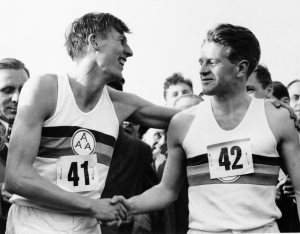 In the final, with Landy the only Australian, it was the Kiwis who adopted what Halberg calls “the Help-Landy plan.” Bill Baillie used a sprinter’s starting crouch, and shot across from the outside to be in front, followed by Halberg. The idea was to keep it fast for Landy, so that his superior endurance would take him clear of Bannister’s fearsome finish. At 220 yards, David Law, a former Oxford University teammate of Bannister, moved past Baillie, perhaps to slow the pace. After a few seconds, Landy moved into top gear, swept past the Kiwis and Law and went through the first 440 yards in 58.2. Bannister split in 58.8, moving past Halberg into second.
In the final, with Landy the only Australian, it was the Kiwis who adopted what Halberg calls “the Help-Landy plan.” Bill Baillie used a sprinter’s starting crouch, and shot across from the outside to be in front, followed by Halberg. The idea was to keep it fast for Landy, so that his superior endurance would take him clear of Bannister’s fearsome finish. At 220 yards, David Law, a former Oxford University teammate of Bannister, moved past Baillie, perhaps to slow the pace. After a few seconds, Landy moved into top gear, swept past the Kiwis and Law and went through the first 440 yards in 58.2. Bannister split in 58.8, moving past Halberg into second.
Now it was a question of whether Landy could put himself out of range. His second lap was 60.0, inexorably opening the gap to 1.2 seconds – 10 yards. It looked almost decisive. But Bannister was imagining the two of them were attached by “some invisible cord” that he could still draw in. On the third lap, he did just that. Landy’s third 440 was 60.2, excellent solo running, pulling them emphatically away from the rest of the field, now led by Rich Ferguson of Canada. Bannister showed perfect precision pace judgment. His third lap was 59.3, almost one second faster than Landy’s. Slowly, smoothly, the gap closed. At the bell, Bannister was on Landy’s heels, poised to strike.
RELATED: Training tips: Add more mileage to improve performance.
Landy might still have won, according to the close-up view of English runner Ian Boyd, who finished sixth. “I think John made an error not to go hard at the bell as Roger was given a chance to ease off a little before he made his move,” Boyd told me in June.
Landy’s last effort came on the back straight of the fourth lap. He pressed, still trying to draw Bannister’s sting. The crowd was roaring. Landy couldn’t hear if Bannister was still there. On the last bend he edged away by a stride. He passed 1,500 m in 3:41.9, only one-tenth outside his world record (Bannister would win the European championship three weeks later in 3:43.8).
As the two came to the end of the last bend, Bannister suddenly seemed to grow taller, as his big stride went higher. He accelerated. The crowd gasped, Landy flashed a quick look over his inside shoulder, and at that instant Bannister soared majestically by on the other side.
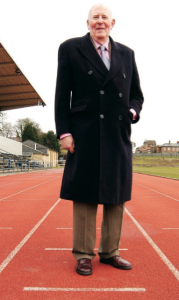 “He lost a valuable fraction of a second in his response to my challenge,” wrote Bannister. “From the other side of the bend, I had a good view of the moment,” recalls Boyd. It was a moment that has stayed in thousands of memories, preserved dramatically on film and destined to be cast in bronze, in the statue that still stands near the grounds of the now-demolished Empire Stadium.
“He lost a valuable fraction of a second in his response to my challenge,” wrote Bannister. “From the other side of the bend, I had a good view of the moment,” recalls Boyd. It was a moment that has stayed in thousands of memories, preserved dramatically on film and destined to be cast in bronze, in the statue that still stands near the grounds of the now-demolished Empire Stadium.
Bannister won by five yards. The cold reality is that they both slowed in the last 50 yards, as all sprinters do in a 100m race. But what the world saw was two men breaking four minutes in a race for the first time in history – 3:58.8 and 3:59.6 – both executing their best tactics.
“I had to run a lone wolf race. It was a clean race. The better man won,” said Landy. “My great respect for him made me bring the best out of myself,” said Bannister. “It was a glorious moment for sport,” wrote Halberg.
Bannister’s time was a British and European record. Ferguson finished the race of his life with a clear third place and Canadian record, 4:04.6. Vic Milligan did the same in fourth (4.05.0, a Northern Ireland record). Halberg and Boyd both ran 4:07.2. Baillie slowed to 4:11, Law lost a shoe and dropped out. Four of the eight – Bannister, Ferguson, Milligan, Boyd – ran personal bests.
After Bannister, no one noticed. Halberg describes how “a seething clutter of officialdom” poured eagerly onto the track. Some carried off the exhausted Bannister.
“The end of the race was a bit of a shambles,” Halberg remembers. Everyone was delirious. The whole world was excited by what Bannister later called “the thrill of competitive struggle.”
The Miracle Mile had lived up to the hype. Sixty-plus years later it still does.
